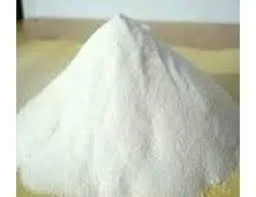
Nov . 27, 2024 18:48 Back to list
Chemical Composition and Structural Features of Hydroxypropyl Methylcellulose
The Chemical Structure of Hydroxypropyl Methylcellulose (HPMC)
Hydroxypropyl methylcellulose (HPMC) is a semi-synthetic polymer derived from cellulose, a natural polymer, which is primarily obtained from plant cell walls. This compound has garnered considerable attention in various industries, notably in pharmaceuticals, food processing, and construction, due to its versatility and functional properties. Understanding the chemical structure of HPMC is crucial for its application and provides insights into its behavior and interaction in different environments.
Chemical Composition
HPMC is produced by the modification of cellulose through a process known as etherification, where hydroxyl groups of cellulose are replaced with methoxy and hydroxypropoxy groups. The chemical formula of cellulose is (C6H10O5)n, where n indicates the degree of polymerization. In HPMC, the cellulose backbone remains intact, but specific hydroxyl groups are substituted.
The methyl (–OCH3) and hydroxypropyl (–OCH2CHOHCH3) groups are introduced to enhance the solubility and utility of cellulose
. The overall structure of HPMC can be represented as follows- The cellulose backbone consists of repeating units of cellobiose, formed by β-(1→4) glycosidic linkages. - The degree of substitution (DS) reflects how many hydroxyl groups have been replaced; it varies based on the intended use of the polymer.
Structural Characteristics
The chemical structure of HPMC allows it to exhibit unique physical and chemical properties. The presence of methoxy and hydroxypropyl groups decreases the intermolecular hydrogen bonding between the cellulose chains, resulting in increased solubility in water. This solubility is highly dependent on the degree of substitution and molecular weight, which can be tailored during the synthesis process to create a product with desired characteristics.
chemical structure of hpmc

HPMC has a non-ionic nature, making it compatible with a wide range of substances, including salts and electrolytes, which is particularly useful in pharmaceutical formulations. The polymer’s solubility profile changes with temperature and pH, allowing for controlled release applications in drug delivery systems.
Applications in Various Industries
In the pharmaceutical industry, HPMC serves as an excipient in tablets and capsules, providing binding and coating properties. Its ability to form gels and films makes it an ideal candidate for controlled drug release formulations. The gel properties of HPMC are exploited in formulations that require a slow release of active ingredients, enhancing therapeutic efficacy while minimizing side effects.
In the food industry, HPMC is utilized as a thickening agent, stabilizer, and emulsifier. It helps improve the texture of products and can enhance the shelf-life of food items by retaining moisture.
In construction, HPMC is used in cement and plaster products, improving workability and providing water retention, which is crucial for prolonged curing times of cement materials.
Conclusion
The chemical structure of hydroxypropyl methylcellulose (HPMC) plays a critical role in determining its functional properties and suitability for various applications. By modifying the cellulose backbone with methoxy and hydroxypropyl groups, HPMC exhibits enhanced solubility and compatibility, making it a valuable ingredient in pharmaceuticals, food products, and construction materials. Its versatility can be attributed to the ability to control its degree of substitution and molecular weight, enabling tailored properties for specific applications. Therefore, understanding the chemical structure and associated characteristics of HPMC not only sheds light on its functionality but also opens avenues for further innovations across several industries.
-
Premium Cellulose Ether: Effective Liquid Thickener Solutions
NewsAug.29,2025
-
HPMC for Tile Adhesive: Enhanced Bonding & Workability
NewsAug.28,2025
-
tile-bonding-additives-for-stronger-bonds
NewsAug.22,2025
-
construction-grade-rdp-for-wholesale-needs
NewsAug.22,2025
-
trusted-hec-supplier
NewsAug.22,2025
-
HEC Solutions for Industrial Excellence
NewsAug.22,2025







